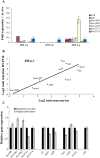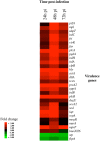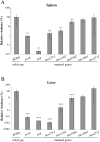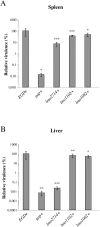In vivo transcriptional profiling of Listeria monocytogenes and mutagenesis identify new virulence factors involved in infection
- PMID: 19478867
- PMCID: PMC2679221
- DOI: 10.1371/journal.ppat.1000449
In vivo transcriptional profiling of Listeria monocytogenes and mutagenesis identify new virulence factors involved in infection
Abstract
Listeria monocytogenes is a human intracellular pathogen able to colonize host tissues after ingestion of contaminated food, causing severe invasive infections. In order to gain a better understanding of the nature of host-pathogen interactions, we studied the L. monocytogenes genome expression during mouse infection. In the spleen of infected mice, approximately 20% of the Listeria genome is differentially expressed, essentially through gene activation, as compared to exponential growth in rich broth medium. Data presented here show that, during infection, Listeria is in an active multiplication phase, as revealed by the high expression of genes involved in replication, cell division and multiplication. In vivo bacterial growth requires increased expression of genes involved in adaptation of the bacterial metabolism and stress responses, in particular to oxidative stress. Listeria interaction with its host induces cell wall metabolism and surface expression of virulence factors. During infection, L. monocytogenes also activates subversion mechanisms of host defenses, including resistance to cationic peptides, peptidoglycan modifications and release of muramyl peptides. We show that the in vivo differential expression of the Listeria genome is coordinated by a complex regulatory network, with a central role for the PrfA-SigB interplay. In particular, L. monocytogenes up regulates in vivo the two major virulence regulators, PrfA and VirR, and their downstream effectors. Mutagenesis of in vivo induced genes allowed the identification of novel L. monocytogenes virulence factors, including an LPXTG surface protein, suggesting a role for S-layer glycoproteins and for cadmium efflux system in Listeria virulence.
Conflict of interest statement
The authors have declared that no competing interests exist.
Figures







Similar articles
-
Identification of Listeria monocytogenes Genes Contributing to Oxidative Stress Resistance under Conditions Relevant to Host Infection.Infect Immun. 2021 Mar 17;89(4):e00700-20. doi: 10.1128/IAI.00700-20. Print 2021 Mar 17. Infect Immun. 2021. PMID: 33495274 Free PMC article.
-
OrfX, a Nucleomodulin Required for Listeria monocytogenes Virulence.mBio. 2017 Oct 31;8(5):e01550-17. doi: 10.1128/mBio.01550-17. mBio. 2017. PMID: 29089430 Free PMC article.
-
Listeria monocytogenes CadC Regulates Cadmium Efflux and Fine-tunes Lipoprotein Localization to Escape the Host Immune Response and Promote Infection.J Infect Dis. 2017 May 1;215(9):1468-1479. doi: 10.1093/infdis/jix118. J Infect Dis. 2017. PMID: 28368435
-
Pathogenic Biohacking: Induction, Modulation and Subversion of Host Transcriptional Responses by Listeria monocytogenes.Toxins (Basel). 2020 May 5;12(5):294. doi: 10.3390/toxins12050294. Toxins (Basel). 2020. PMID: 32380645 Free PMC article. Review.
-
From hot dogs to host cells: how the bacterial pathogen Listeria monocytogenes regulates virulence gene expression.Future Microbiol. 2006 Jun;1(1):89-101. doi: 10.2217/17460913.1.1.89. Future Microbiol. 2006. PMID: 17661688 Review.
Cited by
-
The bacterial pathogen Listeria monocytogenes: an emerging model in prokaryotic transcriptomics.J Biol. 2009;8(12):107. doi: 10.1186/jbiol202. Epub 2009 Dec 30. J Biol. 2009. PMID: 20053304 Free PMC article.
-
DNA probes for unambiguous identification of Listeria monocytogenes epidemic clone II strains.Appl Environ Microbiol. 2010 May;76(9):3061-8. doi: 10.1128/AEM.03064-09. Epub 2010 Mar 19. Appl Environ Microbiol. 2010. PMID: 20305032 Free PMC article.
-
Modifications to the peptidoglycan backbone help bacteria to establish infection.Infect Immun. 2011 Feb;79(2):562-70. doi: 10.1128/IAI.00651-10. Epub 2010 Nov 1. Infect Immun. 2011. PMID: 21041496 Free PMC article. Review.
-
Universal stress proteins are important for oxidative and acid stress resistance and growth of Listeria monocytogenes EGD-e in vitro and in vivo.PLoS One. 2011;6(9):e24965. doi: 10.1371/journal.pone.0024965. Epub 2011 Sep 30. PLoS One. 2011. PMID: 21980369 Free PMC article.
-
Role of GlnR in Controlling Expression of Nitrogen Metabolism Genes in Listeria monocytogenes.J Bacteriol. 2020 Sep 8;202(19):e00209-20. doi: 10.1128/JB.00209-20. Print 2020 Sep 8. J Bacteriol. 2020. PMID: 32690554 Free PMC article.
References
-
- Swaminathan B, Gerner-Smidt P. The epidemiology of human listeriosis. Microbes Infect. 2007;9:1236–1243. - PubMed
-
- Berche P. Bacteremia is required for invasion of the murine central nervous system by Listeria monocytogenes. Microb Pathog. 1995;18:323–336. - PubMed
-
- Cossart P, Toledo-Arana A. Listeria monocytogenes, a unique model in infection biology: An overview. Microbes Infect. 2008;10:1041–1050. - PubMed
Publication types
MeSH terms
Substances
Grants and funding
LinkOut - more resources
Full Text Sources
Other Literature Sources
Medical
Molecular Biology Databases

